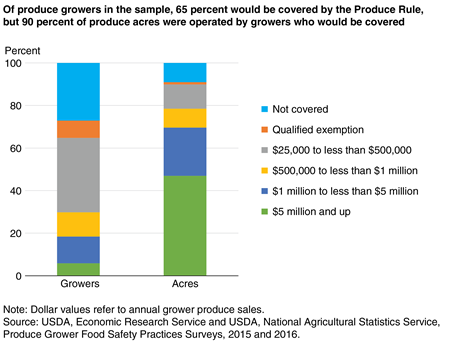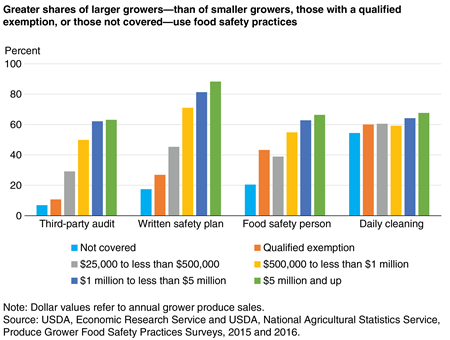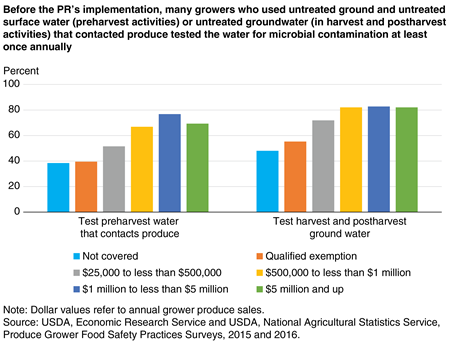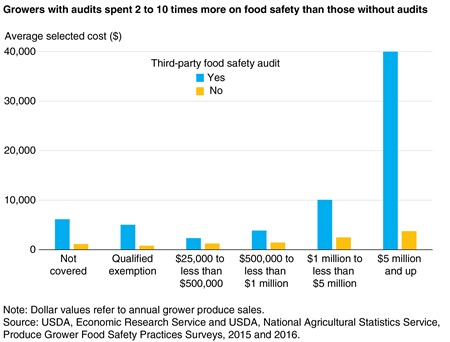New Survey Results Highlight Variation in Food Safety Practices Prior to the Produce Rule

Highlights:
-
Larger growers have consistently adopted food safety practices at higher rates than smaller growers, but even some growers who will not be required to meet Produce Rule (PR) standards used food safety practices.
-
When surveyed (before the PR was enacted), the majority of growers who would be covered by the PR already tested the water they used, although they may or may not have tested it as frequently as the PR requires or met other required criteria.
-
At the time of the survey, growers who conducted third-party food safety audits spent about 2 to 10 times as much on costs measured in the survey as growers that did not audit.
The 2011 Food Safety Modernization Act (FSMA) is the most significant change to U.S. food safety laws over the previous 70 years. One piece of this legislation, the Produce Rule (PR), sets specific disease-preventive requirements for produce that is consumed raw in the United States. These include personnel qualifications and training; health and hygiene; water application; manure products; animal contamination and harvesting; equipment, tools, buildings, and sanitation; and recordkeeping. Enacted in phases beginning in January 2018 for produce growers with more than $500,000 in annual produce sales, with later compliance dates for other groups and other requirements, the PR is the first Federal law covering onfarm food safety for produce.
A baseline of practices used by growers prior to PR implementation is required to understand the the PR’s effects. The last national survey on food safety in produce took place in 1999, when limited knowledge existed about the possibility of microbial contamination in produce. Anticipating the PR’s implementation, USDA’s National Agricultural Statistics Service and ERS teamed to conduct the 2015/16 Produce Grower Food Safety Practices Survey.
Although the legally mandated Federal standards on produce food safety are new, many of the standards themselves are not. For years, many retailer, foodservice, processor, and other buyers have required third-party food safety audits to verify the implementation of food safety standards. Some growers belong to voluntary or mandatory industry programs—like the California Leafy Green Products Handler Marketing Agreement (LGMA) or the Eastern Cantaloupe Growers Association—that require a food safety plan and third-party food safety audits. Produce growers who want to access particular markets must be willing to undergo the third-party food safety audits required by commercial buyers. Some growers undergo multiple audits from different third-party standards to meet multiple buyers’ requirements.
The PR covers all produce that is sold in the United States with a few exceptions. The PR does not cover produce commodities that are grown for personal or onfarm consumption, rarely consumed raw, or processed with a kill step (i.e., cooking, pasteurization, or another process that has been scientifically validated to reduce microbial contamination to a specified level). The PR does not cover growers with average produce sales of $25,000 or less over the last 3 years. The PR also defines a “qualified exemption” for growers with average food sales (produce plus other food crops) of less than $500,000 during the previous 3 years and with more than 50 percent of food sales going directly to “qualified end users.”
In the survey sample, 27 percent of growers are not covered by the PR; 8 percent will likely be able to obtain a qualified exemption; and 65 percent are covered by the rule. In contrast, about 90 percent of produce acres in the sample are operated by growers covered by the PR because many of the growers not covered by the rule or with a qualified exemption operated small acreages. Survey results make clear that many growers who would be required to comply with the PR already had at least some food safety practices in place in 2015/16, and many growers who would not be required to comply had some food safety practices in place as well.
As of 2015/16, larger growers had consistently adopted food safety practices at higher rates than smaller growers
The PR does not require third-party audits or written food safety plans but encourages them. Many retail, foodservice, processor, and other buyers, including USDA’s National School Lunch Program, have required third-party food safety audits for years. Many growers voluntarily adopt food safety plans and third-party audits as a means to manage business risk. A written food safety plan and supporting documentation form the basis for all mainstream third-party food safety audits.
To develop an individual food safety plan, growers develop a set of farm-specific practices that will minimize the risk of introducing food safety hazards. A third-party audit is carried out by an outside auditing firm that inspects the operation and its food safety records to determine whether the operation follows its food safety plan. A third-party audit may be considered to be an imprecise proxy for PR readiness on average, although some audit standards require more or less than the PR requires.
Without legal requirements, in 2015/16, a large share of growers who would be covered by the PR had already implemented food safety practices—like third-party food safety audits and written food safety plans—to mitigate foodborne-illness risks and to access certain markets. Larger growers were more likely to have third-party food safety audits compared to smaller growers. The share of growers who conducted audits is lowest for growers not covered by the PR (7 percent) and increases by size for every group up to the largest (63 percent). This spectrum acoss size groups is also evident for the share of growers who had a written food safety plan—starting with 17 percent among growers not covered and rising to 88 percent of growers with $5 million and up in produce sales.
General differences remain but are less distinct for two PR requirements—employing a food safety person and adequately cleaning equipment and tools. Of growers not covered by the produce rule, 21 percent have a food safety person, compared with 66 percent of growers with $5 million and up in produce sales. However, of growers with a qualified exemption, 43 percent reported having a food safety person versus 39 percent of growers with $25,000 to less than $500,000 in produce sales.
At the time of the survey, other growers would have to adapt to meet the PR’s requirement for a food safety person. The majority of small growers who would be covered by the PR would need to send someone through adequate food safety training to meet the standard. Although they would not be required by the PR to have a food safety person, a share of growers who would have a qualified exemption or who would not be covered nonetheless employed a food safety person to manage food safety risks on their operations in 2015/16.
The differences among groups in the share of growers who cleaned equipment and tools daily are much smaller than group differences for other food safety practices. Among growers who would not be covered by the PR, 54 percent cleaned equipment and tools daily, compared to 68 percent of growers with $5 million and up in produce sales. The PR does not specify how often equipment and tools must be cleaned, only that they must be cleaned and, when necessary, adequately sanitized to prevent the contamination of produce.
Thus, it is difficult to determine how many growers covered by the PR rule would have to adjust their cleaning to comply. Over half of each group clean daily. Among all growers who use equipment and tools, 60 percent of growers reported cleaning daily; 17 percent reported cleaning weekly; 20 percent reported cleaning less often; and the rest reported never cleaning.
Before the PR’s implementation, the majority of growers covered by the PR already tested the water they use
The PR identifies water applications (also a key component of many third-party food safety audits) as a major, potential pathway of microbial contamination of produce and establishes water test standards and testing frequencies for various water sources and uses. This article discusses testing for the two main categories of water covered in the rule: (1) preharvest, untreated ground or surface water that contacts the plants’ edible portions and (2) harvest or postharvest, untreated groundwater in circumstances where it is reasonably likely that contaminants would be transferred to the produce, such as washing produce or washing food contact surfaces.
Before the PR’s implementation, the majority of growers who would be covered under the PR already tested the untreated ground and untreated surface water they used in the field in applications that contacted produce at least once per year. An even larger share of growers covered by the PR tested the untreated groundwater they used in harvest and postharvest activities where it was reasonably likely that contaminants would be transferred to produce. However, not all who were testing their water were testing as frequently as required or using a standard acceptable under the PR. Even some growers who would not be covered under the PR tested the water they used.
Before the PR’s implementation, growers already spent to support food safety on their operations
Survey results provide a general idea of how much growers spent on some of the food safety practices already in place. (These should not be interpreted as the cost of compliance with the PR or a complete measure of costs for food safety practices. Costs included only those for audit fees, water testing, water treatments, harvest worker training materials and hired trainers, and cleaning and sanitizing.) Growers who were not performing food safety practices required under the PR prior to implementation would be likely to incur costs upon implementation. Food safety costs measured in the survey for growers who conducted third-party audits serve as an imprecise proxy for expenses for growers who may already have had enough, or nearly enough, food safety practices to comply with the PR.
Average measured costs for growers with third-party food safety audits ranged from about $2,000 annually for growers with $25,000 to less than $500,000 in produce sales to about $40,000 annually for growers with $5 million or more in produce sales. The smallest difference in average selected costs between growers with and without audits is for those who sold between $25,000 and less than $500,000 in produce annually. This group of growers with audits spent about double that of growers with the same sales but without audits. The largest difference in average selected costs is shown by growers who sold $5 million or more in produce annually. This group with audits spent over 10 times that of growers with the same sales but without audits. Even growers who did not conduct third-party food safety audits spent money on food safety practices. Presumably, these growers would need to increase their spending on food safety practices to meet PR requirements.
Continued development of food safety standards within the produce industry
The statistics published from the 2015/16 Produce Grower Food Safety Practices Survey show that many U.S. produce growers used food safety practices before the PR took effect. Before the PR’s implementation, growers decided which food safety practices to use to manage their own risks of microbial contamination and to meet commercial buyer requirements. However, some growers (more commonly small growers than large growers) would have to implement new food safety practices to meet the new standards in the PR.
Before Implementation of the Food Safety Modernization Act's Produce Rule: A Survey of U.S. Produce Growers, by Gregory Astill, Travis Minor, Linda Calvin, and Suzanne Thornsbury, ERS, August 2018





